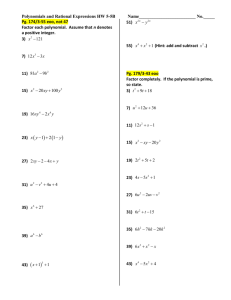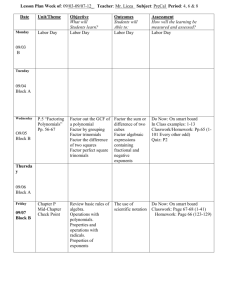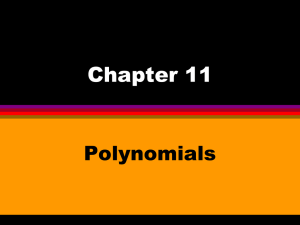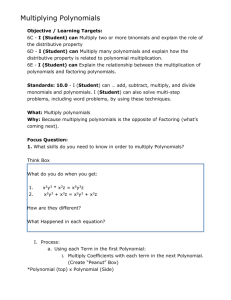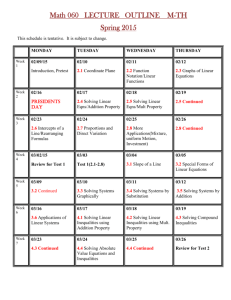Algebra 1 Laws of Exponents/Polynomials Test Study Guide Page
advertisement
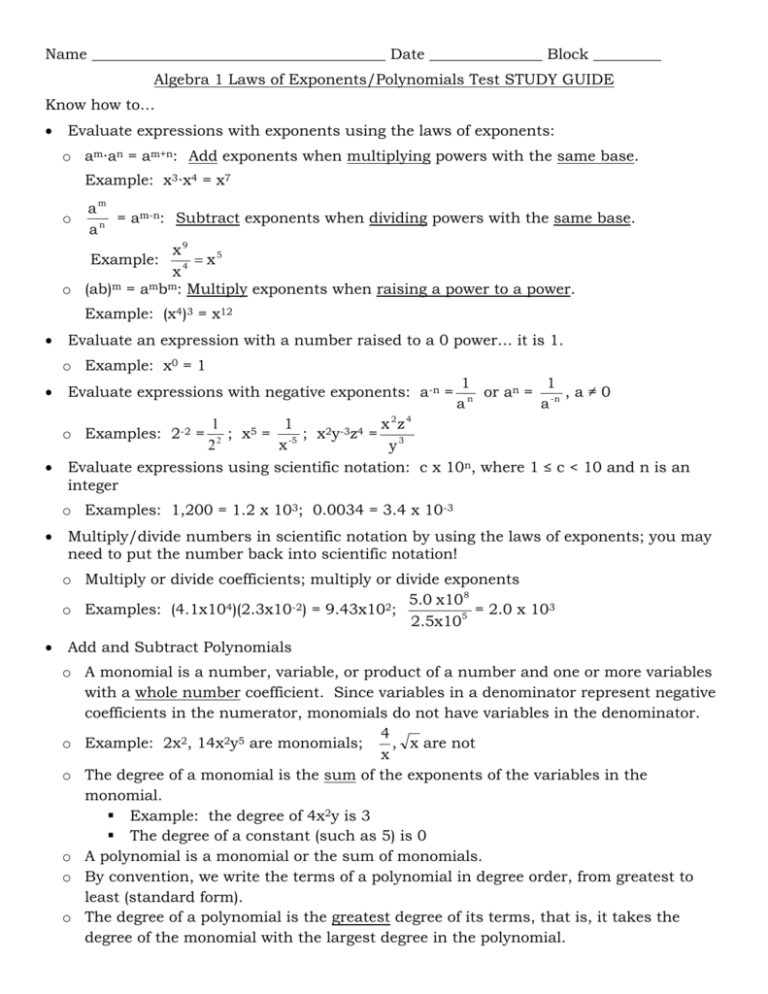
Name _______________________________________ Date _______________ Block _________
Algebra 1 Laws of Exponents/Polynomials Test STUDY GUIDE
Know how to…
Evaluate expressions with exponents using the laws of exponents:
o am∙an = am+n: Add exponents when multiplying powers with the same base.
Example: x3∙x4 = x7
am
= am-n: Subtract exponents when dividing powers with the same base.
an
x9
x5
Example:
4
x
o (ab)m = ambm: Multiply exponents when raising a power to a power.
o
Example: (x4)3 = x12
Evaluate an expression with a number raised to a 0 power… it is 1.
o Example: x0 = 1
Evaluate expressions with negative exponents: a-n =
1
1
or an = -n , a ≠ 0
n
a
a
1
1
x 2z 4
5 =
2y-3z4 =
;
x
;
x
22
x -5
y3
Evaluate expressions using scientific notation: c x 10n, where 1 ≤ c < 10 and n is an
integer
o Examples: 2-2 =
o Examples: 1,200 = 1.2 x 103; 0.0034 = 3.4 x 10-3
Multiply/divide numbers in scientific notation by using the laws of exponents; you may
need to put the number back into scientific notation!
o Multiply or divide coefficients; multiply or divide exponents
5.0 x108
o Examples: (4.1x104)(2.3x10-2) = 9.43x102;
= 2.0 x 103
2.5x105
Add and Subtract Polynomials
o A monomial is a number, variable, or product of a number and one or more variables
with a whole number coefficient. Since variables in a denominator represent negative
coefficients in the numerator, monomials do not have variables in the denominator.
4
, x are not
o Example: 2x2, 14x2y5 are monomials;
x
o The degree of a monomial is the sum of the exponents of the variables in the
monomial.
Example: the degree of 4x2y is 3
The degree of a constant (such as 5) is 0
o A polynomial is a monomial or the sum of monomials.
o By convention, we write the terms of a polynomial in degree order, from greatest to
least (standard form).
o The degree of a polynomial is the greatest degree of its terms, that is, it takes the
degree of the monomial with the largest degree in the polynomial.
Algebra 1 Laws of Exponents/Polynomials Test Study Guide
Page 2
Example: the degree of 5x3y4 + 6x2 + 4xy + 6 is 7
o Add polynomials by combining like terms.
o Subtract polynomials by distributing the negative sign, and then adding.
Multiplying Polynomials
o Multiply a monomial by a polynomial by distributing the monomial over all the terms
in the polynomial.
o Multiply polynomials by performing multiple distribution for each term in the first
polynomial over every term in the second monomial.
o The FOIL acronym (“First, Outside, Inside, Last”) is a way to remember how to
multiply two binomials.
Special Polynomial Products
o Square of a polynomial pattern: (a + b)2 = a2 + 2ab + b2 and (a – b)2 = a2 – 2ab + b2.
o Sum and difference pattern: (a + b)(a – b) = a2 – b2
Solving Polynomials
o Make sure all terms are one side of the equation, and 0 is on the other.
o Factor completely (see below for factoring summary).
o Use the zero product property (if ab = 0, then a = 0 or b = 0) to solve.
Factoring
o Always apply Type I factoring (factor out GCF) before factoring any polynomial!!
o Always multiply your answer back to a polynomial to verify!!
o Type I Factoring – factor out GCF
o Factor out the Greatest Common Factor (GCF) of the terms in the polynomial
o Example: 4x4 + 24x3 = 4x3(x + 6)
o Type II Factoring – notice special patterns
o If polynomial follows special product pattern (as described in section 9.3), we can
easily factor: a2 – b2 = (a + b)(a – b) or a2 + 2ab + b2 = (a + b)2
o Example: x2 – 81 = (x + 9)(x – 9)
o Type III Factoring – Factor x2 + bx + c
o Draw two sets of parentheses, with the variable as the first term in each.
o Find two factors of c that add up to b (when c is positive) or subtract to b (when c
is negative)
o When c is positive, the signs in the parentheses will be the same (the sign of b)
o When c is negative, the signs in the parentheses will be different (the bigger
number takes the sign of b)
o Example: x2 – x - 6 = (x – 3)(x + 2)
o Type IV Factoring – Factor by Grouping
o Applies when a polynomial has 4 terms
o Group the first two terms, and the second two terms; factor out the GCF for each
set
o Factor out the common polynomial
o Example: x3 – 3x2 + 2x – 6 = (x3 – 3x2) + (2x – 6) = x2(x – 3) + 2(x – 3) = (x – 3)(x2 + 2)
o Type V Factoring – Factor ax2 + bx + c
Algebra 1 Laws of Exponents/Polynomials Test Study Guide
Page 3
o There are several methods for factoring – here is the grouping method:
Multiply ac, and find the factors of ac that add or subtract to b.
Re-write the polynomial, splitting up b into the sum found above.
Factor by grouping.
o Example: Factor 2x2 – 7x + 3
a∙c = 2∙3 = 6; the factors of 6 that add up to 7 are 1 and 6
Re-write: 2x2 – 6x - x + 3
Group and factor: (2x2 – 6x) + (-x + 3) = 2x(x – 3) - (x – 3)
Factor common binomial: (x – 3)(2x – 1)
o A polynomial is factored completely when each factor is prime, that is, each factor
cannot be factored further. Always check each factor for further factoring (especially
look for further Type I (GCF) or Type II (special product) factoring).
Study Questions
1) Evaluate the expressions, writing answers using positive exponents:
b) (133)10
a) 83 ∙ 811
e)
65
62
i)
1
x 25
4
x
32
m) 8
w
4
x 4 y 10 z 7
q)
14
6x
u)
f)
42 ×45 ×44
43
j)
(-3x2y5)2
n) 86 ∙
0-10
1
813
c) (4∙12)6
g) x5∙x12
k)
(-3y5)3
r)
v)
1
(5y)3
h)
∙
2y2
7
1
o) ∙ 517
5
x 11
x4
b
l)
c
7
m7
p) 10
2n
6
s)
x 5
x 4
t) (4x)4∙4-3
w)
(7x5y-4)-6
x4
x)
3
0
2-3
d) 32∙34∙3∙37
3
2) Re-write the numbers in scientific notation.
a) 48,100
b) 6,235,000
c) 0.05
d) 0.001429
c) 4.5 x 10-5
d) 6.7 x 10-1
3) Re-write the numbers in standard form.
a) 4.06 x 105
b) 3.142 x 103
Algebra 1 Laws of Exponents/Polynomials Test Study Guide
Page 4
4) Multiply or divide. Express results in scientific notation.
a) (4.9 x
104)(3.8
x
106)
b) (7.3 x
106)(4.2
x
10-9)
c)
6.2×106
3.1×103
d)
2.272×10-8
7.1×10-5
5) Tell whether the following are monomials; if yes, what is the degree; if not, why not?
a) 4x2y3z4
b)
5x 1
y2
c) 5 x
6) What is the degree of the polynomial? 5x4y2 + 4xy + 3x + 9
7) Add or subtract the polynomials:
a) (5a2 – 3) + (8a2 – 1)
b) (4m2 – m + 2) + (-3m2 + 10m + 7)
c) (9b3 – 13b2 + b) – (-13b2 - 5b + 14)
8) Multiply the polynomials:
a) x(2x2 – 3x + 9)
b) -5b3(4b5 – 2b3 + b – 11)
c) (b – 2)(b2 – b + 1)
d) (y + 6)(y – 5)
e) (2x + 4)(2x – 4)
f) (2x + 3)2
g) (5x – 8)(2x – 5)
h) (7w + 5)(11w – 3)
i) (7a – 2)(3a – 4)
b) 3x -7 3x 2 - x -14
c) 3x -5 6x 2 -13x +11
9) Divide the polynomials:
a) 6x 30x 4 -12x 3 +6x 2
Algebra 1 Laws of Exponents/Polynomials Test Study Guide
10)
Page 5
Factor completely:
a) 2x + 2y
b) 7w5 – 35w2
c) 25x2 - 100
d) x2 + 11x + 18
e) n2 – 6n + 8
f) -y2 - 2y + 15
g) x2 – 2x - 24
h) 8x2 – 10x + 3
i) x4 - 1
a) (2x – 3)(x + 2) = 0
b) x2 + 3x = 18
c) x2 - 14x + 45 = 0
d) x2 – 10x + 25 = 0
e) 2x2 – 3x – 35 = 0
f) m3 – 3m2 = 4m - 12
g) 7a2 + 2a = 0
h) 6x3 – 36x2 + 30x = 0
11) Solve (find the roots):
12) Find the zeros of the functions.
a) f(x) = 7x2 + 2x - 5
b) f(x) = 5x3 – 30x2 + 40x
c) f(x) = 6x2 – 5x - 14
13) The length of a rectangle is 7 inches more than 5 times its width. The area of the
rectangle is 6 square inches. What is the width?
x
5x + 7
Algebra 1 Laws of Exponents/Polynomials Test Study Guide
STUDY QUESTION ANSWERS
1) a) 814 b) 1330 c) 46∙126 d) 314 e)
63 f) 48 g) x17 h) x7 i) x21
3
b
m 42
1
j) 9x4y10 k) -54y17 l) 7 m) 32 n) 7 o) 510 p)
8
w
c
64n 60
y 24
x12
1
1
q) 1 r)
s)
t) 4x4 u) undefined v) 125y3 w) 6 30 x) 8
x
7 x
27
4
6
-2
-3
2) a) 4.81 x 10 b) 6.235 x 10 c) 5.0 x 10 d) 1.429 x 10
7
3) a) 406,000 b)
8
3,142 c) 0.000045 d) 0.67
4) a) 1.862 x 1011 4b) 3.066 x 10-2 4c) 2.0 x 103 4d) 3.2x10-4
5) a) yes; degree is 9
b) no; contains exponents that are not whole numbers
c) no; can’t have variables under the radical sign
6) degree is 6
7) a) 13a2 – 4 b) m2 + 9m + 9 c) 9b3 + 6b – 14
8) a) 2x3 – 3x2 + 9x b) -20b8 + 10b6 – 5b4 + 55b3 c) b3 - 3b2 + 3b -2
d) y2 + y – 30 e) 4x2 – 16 f) 4x2 + 12x + 9 g) 10x2 – 41x + 40
h) 77w2 + 34w – 15 i) 21a2 – 34a + 8
9)
a) 5x3 – 2x2 + x
b) x + 2
c) 2x – 1 +
6
3x - 5
b) 7w2(w3 – 5) c) 25(x + 2)(x – 2) d) (x + 9)(x + 2)
e) (n – 4)(n - 2) f) -(y - 3)(y + 5) g) (x – 6)(x + 4)
h) (2x – 1)(4x – 3) i) (x2 + 1)(x + 1)(x – 1)
3
7
11) a) {-2, } b) {-6, 3} c) {5, 9} d) {5) e) {- , 5} f) {-2, 2, 3}
2
2
2
g) {- , 0} h) {0, 1, 5}
7
5
7
12) a) x =-1,
b) x = 0, 2, 4 c) x = - , 2
7
6
3
13) in.
5
10) a) 2(x + y)
Page 6

